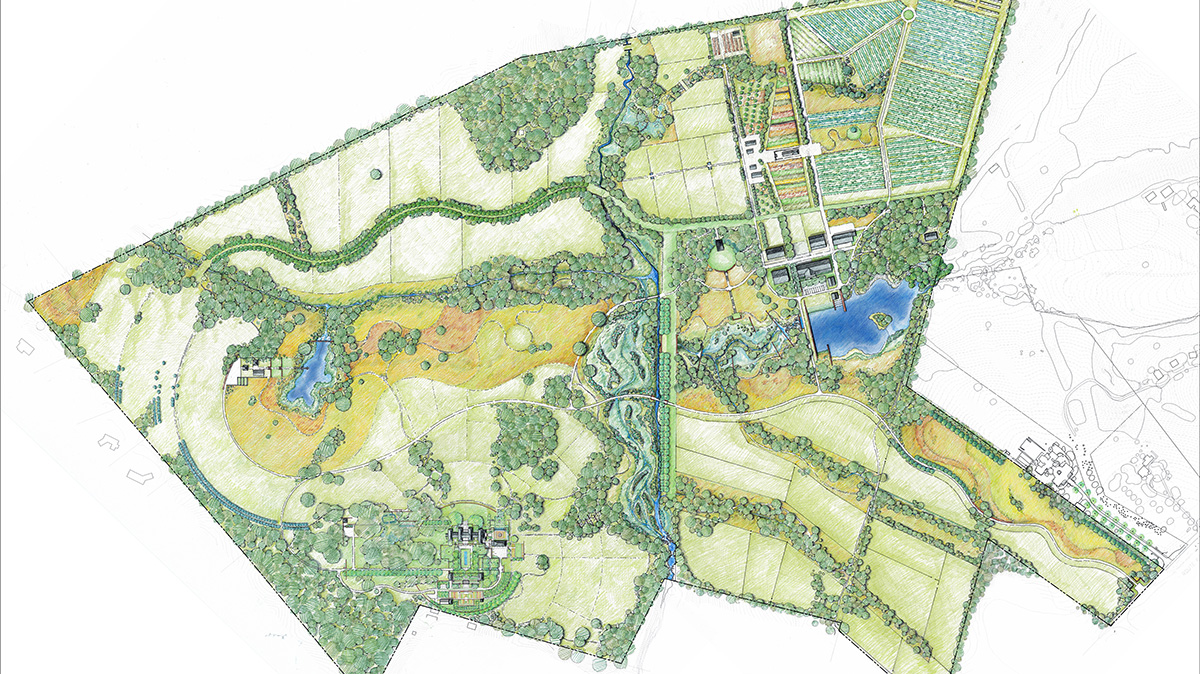
Oakencroft Farm master plan in Central Virginia, Nelson Byrd Woltz Landscape Architects.
Nelson Byrd Woltz Landscape Architects created a master plan for a model sustainable agricultural landscape at Oakencroft Farm in central Virginia that would protect soil health, promote environmental conservation, and yield organic food. Conventional farming methods had left the property damaged, lacking in biodiversity, with degraded riparian habitat and forests that were unable to regenerate due to the spread of invasive plants. The goal of the master plan was to create a new balance between agriculture production and ecological conservation. The plan includes space for cattle rotation; 15 acres of wetlands and a riparian corridor to improve water management; restored forests and wetlands; protected wildlife corridors; and insectaries to increase the number of pollinators.
Background:
For a quarter of a century, Oakencroft was one of the region’s oldest and best-known vineyards. The vineyard used conventional viticulture methods, along with standard grazing methods to support a small cattle ranch.
When the land was sold in 2008, it was then a conservation easement. The new owners brought in Nelson Byrd Woltz Landscape Architects to create a new balance between agriculture production and ecological conservation.
Nelson Byrd Woltz used a science-driven approach when planning the future of Oakencroft Farm. In collaboration with the SUNY College of Environmental Science and Forestry, they brought in a team of 17 university field scientists to conduct a BioBlitz exercise. The team spent three days creating an ecological baseline that cataloged animal populations, plant life, and soil quality. Temperature sensors were also installed throughout the site to monitor microclimates.
With this snapshot in hand, the firm crafted a master plan for protecting soil health, promoting conservation and biodiversity, and growing organic produce.
The master plan also called for mob grazing and space for cattle rotation; 15 acres of wetlands and a riparian corridor to improve water management; restored forests and wetlands; protected wildlife corridors; and insectaries to increase the number of pollinators.
The current owners of Oakencroft Farm are committed to ecological conservation and creating a farm that is wholly self-sustaining. They plan to do a second ecological snapshot in a few years’ time to gauge their progress and plan for future improvements.
- Oakencroft Farm, Nelson Byrd Woltz Landscape Architects
- Restoration Ecology in Agrarian Landscapes, The Dirt, 2011
- Thomas Woltz: Wild By Design, Garden & Gun
- Landscape Agriculture: Landscape Design Lessons Learned from the Farming Communities of Rural Appalachia, MLA Thesis, University of Virginia
- Oakencroft Vineyard and Winery to close after 25 years, CVille
- Design Collaborations for Conservation, The Dirt, 2015
- Conserves farmland and protects soils.
- Includes opportunities for urban and suburban agriculture in community planning.
- Promotes healthy soil education and practices, restoring the ability of soil to sequester carbon.
- Follows best practices for planting and maintenance of trees and vegetation.
- Protects, expands, and restores natural systems, including wetlands.
- Incorporates water conservation and water reuse technologies.
- Uses biohabitat-supporting and pollinator-friendly plant species appropriate to the region and changing climate conditions.

Oakencroft Farm in Central Virginia, Nelson Byrd Woltz Landscape Architects.